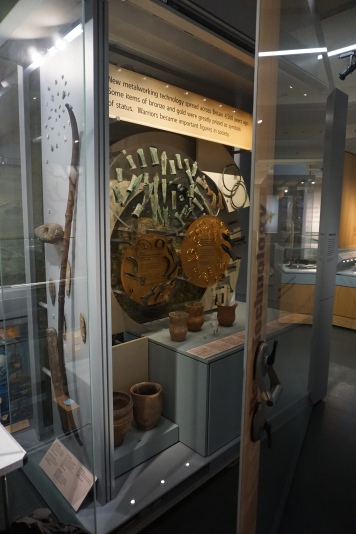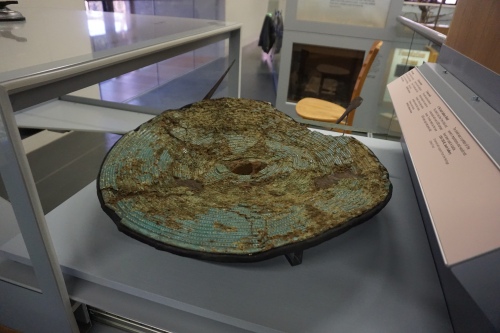Music echoed through the empty gallery.
Christina Aguilera, Sean Paul, UB40…
There was no rhyme or reason – the iPod’s owner clearly had an eclectic taste!
Underneath is all, faint atmospheric noises from the exhibits eerily accompanied silent projections on the walls, ongoing despite the absence of visitors.
I, meanwhile, sat on the walkway above, tapping my feet, looking out over a prehistoric canoe suspended c.10 foot in the air above a plesiosaur skeleton set within the floor below.

The view to my left was a cabinet full of Iron Age skulls, while on the right a floor-to-ceiling glass case swung open, presenting a veritable Pandora’s Box of Bronze Age treasures.

The Museum of Somerset, set within Taunton Castle, holds roughly 100 pieces of BA metalwork relevant to my PhD – however, as it is open to the public the majority of the week, finding a convenient time to get in and study these pieces was problematic.
Fortunately though, the entire museum shuts down for one week every January to clean all the displays, and touch up the inevitable wear and tear that accumulates from accommodating over one hundred thousand visitors(!), giving me the much desired opportunity to pry open the cases and sift through the objects – provided I didn’t get in the way of the cleaning!
I was ushered through the Castle gates on Monday morning and directed to my makeshift desk. The usually thriving archaeology gallery was a desolate scene of dust sheets, step ladders, and a menagerie of makeshift cleaning tools. And of course a small set of speakers blaring motivational music in the corner.
“When you take something off display, remember how to put it back in again!” I was warned. Each object sits very specifically on a series of hooks and prongs that interlink and weave to create the dynamic display – it would be easy to confuse what went where!
And so I began.
Left to my own devices I was allowed to pick and choose the pieces I wanted to analyse and make notes at my leisure. I of course chose to go through everything. Somerset has some of the most interesting pieces of destroyed metalwork from the South West and these objects are easily some of my favourites.
The shield from South Cadbury, for instance, was deposited in an enclosure ditch and stabbed through three times with a wooden stake, while the 17 Priddy bracelets were found compressed into a ball in the ground.

Of course, in a collection such as this, the pristine objects often take precedence and there was no shortage of other artefacts to distract me.
A gold torc from Yeovil had, for whatever reason, been coiled up into a bracelet upon discovery, though it remains one of the most finely made pieces from the area.
The Edington Burtle hoard of tools and ornaments, on the other hand, was found in a small wooden box while peat cutting in the 19th century and remains intact.

And preserved for selfies.
Often I only get a few hours with each collection I study, interrupted by sometimes weeks at a time. Last week I had the pleasure of spending every day at Taunton and the difference in how I appreciate and understand the collections is quite noticeable.
The similarities and differences in how different materials and objects are treated are clearly observed, and it’s easier to start interpreting the artefacts as a whole, rather than as sporadic display pieces.
Because the important thing to remember about the Bronze Age, as with any society, is that most of their actions and practices are culturally embedded. They weren’t depositing and destroying objects randomly, or without accordance to a pre-understood set of rules. They had full consciousness of what they were doing and why.
We will never exactly know what made the Edington Burtle hoard so significant it required depositing in a box in a bog, or why the Cadbury Shield needed to be stabbed.
But by looking at every individual piece in the context of the landscape it was set in and the other pieces that display similar practices we can start to get an inclination.
And while that’s all being worked out, I urge you to go to the Museum of Somerset and see these incredible pieces.
But leave the iPod at home.
Acknowledgements
Thanks to all the staff, volunteers, cleaners and anyone else who accommodated me and was inconvenienced at my expense at the Museum of Somerset! All photos are my own, taken courtesy of the South West Heritage Trust (Museums Service).













[…] like to introduce you all (again!) to my favourite Bronze Age object in South West England (and possibly Bronze Age Europe): the […]
LikeLike